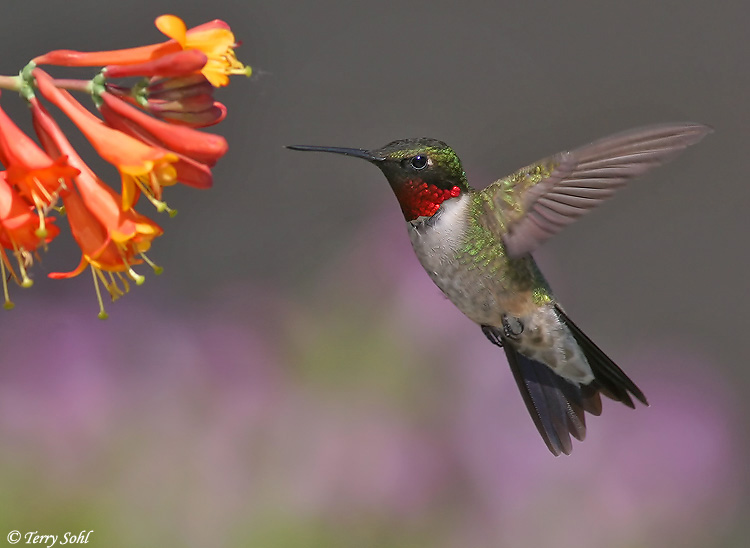| Return to Main Page | Dakota Birder Blog | Follow @DakotaBirder |
![]()
 Ruby-throated
Hummingbird
Ruby-throated
HummingbirdMy neighbors think I'm weird. I'm positive of that. I'm sure they're not the only ones who think the nerd with the camera is weird, but I DO wonder what they think sometimes when they see me...
We built a new house in a new neighborhood in 2007. I've done all the landscaping myself, with much of it designed to attract birds. It's a bit of a delayed gratification waiting for the landscaping to mature, but even from the start, I had enough berry bushes, young trees, and flower plants to attract some kinds of birds. A highlight of every spring for me, after a long South Dakota winter, is the first arrival of Ruby-throated Hummingbirds. We're on the fringe of their range, but they are very reliable residents of my yard. Without fail, they arrive within a day or two of May 6th, and stay until mid-September.
Ruby-throated Hummingbirds haven't even been confirmed as nesting birds in South Dakota, but it's quite obvious they do nest here, given that I have them all summer long, and I start to see young birds in July. In my yard, they're not only frequent visitors to my nectar feeder, they also come for the landscape plants I put in specifically to attract hummingbirds. Their favorite by far are the honeysuckle bushes I have planted in several locations. The biggest and most productive flowering honeysuckle is right by our front entrance, and it never fails to attract hummingbirds.
Getting great shots of Hummingbirds isn't that difficult in my mind. One reason for that is that they seem to be much less shy around people than other birds. I can often stand out on my back deck, where my nectar feeder hangs, and hummingbirds will come and feed within mere feet of me as I stand there. But who wants photos of hummingbirds sitting at a plastic feeder? What could be better than getting a photo of a hovering hummingbird as it feeds on a beautiful honeysuckle plant?
The hummingbirds in my yard seem to have a pretty regular schedule, coming back to the same locations in the yard every 15-20 minutes as they feed on nectar. Given their generally tame nature, it's often just a matter of waiting by one of their favorite haunts, waiting for the hummingbirds to make their periodic feeding stops.
The problem? When their favorite feeding spot is a big honeysuckle right by your front entrance, you necessarily need to wait out in front of your house where your neighbors can all see you! What would YOU think when you see the weird neighbor hanging outside with a pair of binoculars and a camera with a BIG lens? Yeah, they probably think I'm spying on them or something. It's funny, no neighbor has ever said anything. I think they're scared to ask why I'm walking around with this big camera lens, occasionally (but only incidentally) pointing that lens in the general direction of THIER house!
This is one of my favorite photos, taken on a beautiful spring day in front of my house as I waited for this gorgeous male Ruby-throated Hummingbird to return to feed. Did I get some odd stares from the neighbors? Sure! I also got a heck of a nice hummingbird photo!
From a technical aspect, you might think shooting hummingbirds is difficult. Many "professionals" use very elaborate flash setups, using multiple flashes and staged settings to complete stop motion. Fine...more power to them. You don't need a multiple flash set up to get GREAT hummingbird photos. Hanging out in front of my house and hand-holding while I shot got me this photo. I actually don't feel like I WANT to completely "stop motion" when shooting hummingbirds. I love this photo because the bird's body, head, and bill are in great, sharp focus, but there's a twinge of motion blur in the wings, giving the photo a bit of the feel of the hovering bird. Even a fast shutter speed of 1/1600th of a second wasn't enough to completely stop motion in the wings, but I like the resultant effect. The only other technical component I typically use when shooting hummingbirds, particularly male hummingbirds, is to use fill-flash. The gorget (throat) of male hummingbirds can be tough to photograph as "lit up", as the light has to be from the right angle for the gorget to flash its gorgeous colors. Adding a touch of fill-flash can help bring out the color of the gorget though.
If you're going to be a bird photographer, you can't be shy! You can't be afraid to be the one "weird" guy walking around with the big camera, be it in a city park, the local walking path, or even your own yard!!
| Camera Body: | Canon 20D | |
| Camera Lens: | Canon 400mm 5.6L | |
| ISO: | 400 | |
| Aperture: | f/7.1 | |
| Shutter Speed: | 1/1600th | |
| Flash: | Fill-flash, FEC -1 2/3rds | |
| Support: | Hand-held | |
| Date: | 06/10/2008 | |
| Location: | Brandon, South Dakota |
All photos copyrighted! Click for information on commerical usage, or usage for other personal purposes.
Use the following Google dialogue to search this South Dakota Birds and Birding site:

Custom Search
|
SOUTH DAKOTA BIRDS AND BIRDING - LOCATIONS OF WEBSITE VISITORS
Please mail any comments/suggestions/additional links for this page to: Terry L. Sohl